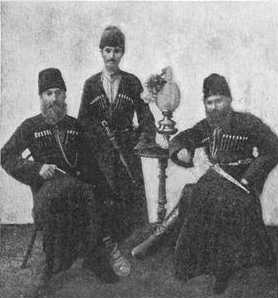Judeo-Persian refers to both a group of Jewish dialects spoken by the Jews living in Iran and Judeo-Persian texts. As a collective term, Judeo-Persian refers to a number of Judeo-Iranian languages spoken by Jewish communities throughout the formerly extensive Persian Empire, including the Mountain and Bukharan Jewish communities.

Mountain Jews or Caucasus Jews also known as Juhuro,Juvuro,Juhuri,Juwuri, Juhurim,Kavkazi Jews or Gorsky Jews are Jews of the eastern and northern Caucasus, mainly Azerbaijan, and various republics in the Russian Federation: Chechnya, Ingushetia, Dagestan, Karachay-Cherkessia, and Kabardino-Balkaria. They are the descendants of Persian Jews from Iran. The Mountain Jews took shape as a community after Qajar Iran ceded the areas in which they lived to the Russian Empire as part of the Treaty of Gulistan of 1813.
Luri is a Southwestern Iranian language continuum spoken by the Lur people, an Iranian people native to Western Asia. The Luri dialects are descended from Middle Persian and are Central Luri, Bakhtiari, and Southern Luri. This language is spoken mainly by the Bakhtiari and Southern Lurs in Iran.
The Median language was the language of the Medes. It is an Old Iranian language and classified as belonging to the Northwestern Iranian subfamily, which includes many other languages such as Old Azeri, Gilaki, Mazandarani, Zaza–Gorani, Kurdish, and Baluchi.

Judaeo-Aramaic languages represent a group of Hebrew-influenced Aramaic and Neo-Aramaic languages.

The Tat language, also known as Tat/Tati Persian, is a Southwestern Iranian language closely related to, but not fully mutually intelligible with Persian and spoken by the Tats in Azerbaijan and Russia. There is also an Iranian language called Judeo-Tat spoken by Jews of Caucasus.
Judeo-Tat or Juhuri is the traditional language of the Mountain Jews of the eastern Caucasus Mountains, especially Azerbaijan and Dagestan, now mainly spoken in Israel.

Persian Jews or Iranian Jews are Jews historically associated with the Persian Empire, whose successor state is Iran. The biblical book of Esther contains references to the life and experiences of Jews in Persia. Jews have had a continuous presence in Iran since the time of Cyrus the Great of the Achaemenid Empire. Cyrus invaded Babylon and freed the Jews from Babylonian captivity.
Judeo-Shirazi is a dialect of Fars. It is spoken mostly by Persian Jews living in Shiraz and surrounding areas of the Fars Province in Iran.

Baba Tahir or Baba Taher Oryan Hamadani was an 11th-century dervish poet from Hamadan, Iran who lived during the reign of Tugril of the Seljuk dynasty over Iran. This is almost all that is known of him as he lived a mysterious lifestyle. Although prefix "Baba" has been thought as part of his name in all known sources, his nickname "Oryan" did not appear until about 17th-century.The nickname was probably attributed to him because he seemed to lead a very spiritual and stoic lifestyle and thus was figuratively not clothed with worldly and material needs. His poetry is written in the Hamadani dialect of the Persian language. According to L. P. Elwell-Sutton he probably wrote in the Hamadani dialect, adding: "Most traditional sources call it loosely Luri, while the name commonly applied from an early date to verses of this kind, Fahlaviyat, presumably implies that they were thought to be in a language related to the Middle Persian language. Rouben Abrahamian however found a close affinity with the dialect spoken at the present time by the Jews of Hamadan." According to The Cambridge History of Iran, Baba Tahir spoke a certain Persian dialect.

Mazandarani (مازندرانی) is an Iranian language of the Northwestern branch, spoken by Mazandarani people with 2,320,000 native speakers in 2019. As a member of the Northwestern branch, etymologically speaking it is rather closely related to Gilaki, and also related to Persian, which belongs to the Southwestern branch. Though the Persian language has influenced Mazandarani to a great extent, Mazandarani language still remains as an independent language with a northwestern Iranian origin. Mazandarani is closely related to Gilaki and the two languages have similar vocabularies. The Gilaki and Mazandarani languages share certain typological features with Caucasian languages, reflecting the history, ethnic identity, and close relatedness to the Caucasus region and Caucasian peoples of Mazandaranis and Gilak people.
The Western Iranian languages are a branch of the Iranian languages, attested from the time of Old Persian and Median.
The Semnani languages are a group of Northwestern Iranian languages, spoken in Semnan province of Iran that share many linguistic features and structures with Iranian languages. These languages are also called "dialects" in some sources. The Semnani languages are descendants of the extinct Parthian whereas the Caspian languages are descended from the extinct Median.
Hamadani, Hamedani or Hamadhani denotes something or someone related to the town of Hamadan in Iran, and may refer to:
Judæo-Golpaygani was a language spoken by the Jewish community living in Golpaygan, in western Isfahan, western Iran. The first records of Jewish communities in this region date to approximately 750 BC.

The Judeo-Iranian languages are a number of related Jewish variants of Iranian languages spoken throughout the formerly extensive realm of the Persian Empire. Judeo-Iranian dialects are generally conservative in comparison with those of their Muslim neighbours. Judeo-Shirazi, for example, remains close to the language of Hafez.

Hamadan or Hamedan is the capital city of Hamadan Province of Iran. At the 2019 census, its population was 783,300 in 230,775 families.
Rouben Abrahamian, born Ṛubēn Tʻadēosi Abrahamyan was an Armenian Iranologist, linguist and translator.
Hamadani, Hamedani or Hamadhani is an Arabic nisbah that denotes an origin from Hamadan. It is commonly used for Badi' al-Zaman al-Hamadani, but the many notable people with the surname include:









